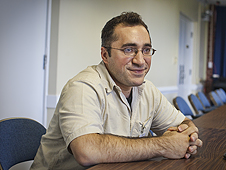Imagine: a glucose monitor for diabetics directly on the eye. Cholesterol checking or infection detection. Blood screening available anytime. Even a computer display.

Health monitoring contact lens on a rabbit’s eye. Picture courtesy of University of Washington
This is the vision of Babak Parviz, an innovation professor and researcher at the University of Washington. During his presentation, “What if your contact lenses could show you images …” at the August colloquium at the NASA Langley Reid Conference Center, Parviz explained new technology being developed that someday will be integrated into devices millions use now to avoid wearing glasses.
“With our expertise, which is in building really tiny devices, we are interested in turning a contact lens into a functional system that does a lot more than just improve vision,” Parviz said.
“A lot of people may not know that the surface of the eye is covered by live cells,” Parviz said of the initial push toward biomedical monitoring. “Every time that you see something, light from the outside is going through live cells of your body to reach the retina in your eye.”
Sensors on the contact lenses could monitor the body chemistry and gather information that will determine the health status of the person.
“In a sense, you can monitor what happens in the body without going inside,” Parviz said.
Information display is in the more distant future. For example, it’s possible that a computer screen will be part of a contact lens, rather than a person depending on a display on a computer monitor or a smart phone.
The ultimate goal is to produce an energy-efficient, lightweight, non-intrusive device that is affordable, disposable and works continuously.
This is by no means a simple task.
“It’s absolutely not science fiction anymore,” Parviz said. “We are talking about constructing very sophisticated contact lenses.”
The lenses have been tested on rabbits without being activated. Within the next year, the lenses will be turned on during testing.
Testing on humans comes later.
 |
| Babak Parviz, leads research at the University of Washington, developing multiple uses for contact lenses. Photo courtesy of NASA/Sean Smith. |
The indicators of the lenses that have been created thus far are composed of only one pixel. The pixels that have been created are red or blue. They are still working to produce a green pixel, “to have full color capabilities,” Parviz said.
These pixels can be either square or donut shaped.
Parviz and his team have created a radio that is a little bigger than the diameter of a strand of human hair.
“We can make a contact lens right now that has antenna, radio and a light source,” Parviz said.
The lenses are more rigid that the traditional contact lenses and are wirelessly powered.
In the future, Parviz imagines that the wireless power will come from a person’s cellular phone, and could interface with the capabilities of a smart phone.
It is difficult to fit all of these components into the size of a small contact lens. Because Parviz is working with microscopic components, he uses a novel technique called self-assembly. It involves components that are created in specific shapes along with a circuit board of matching shapes. Then the components are suspended in a liquid and washed over the board until the pieces fall into the correct places.
Meeting these challenges requires an interdisciplinary team of scientists. Parviz enlists the support of chemical engineers, electrical engineers, mechanical engineers, physicists and other scientists, as well as many graduate students to accomplish program goals.
Although it will take some time, these advancements could one day change the ways in which we see our world.
This story was first reported in Researcher News: NASA Langley Research Center


